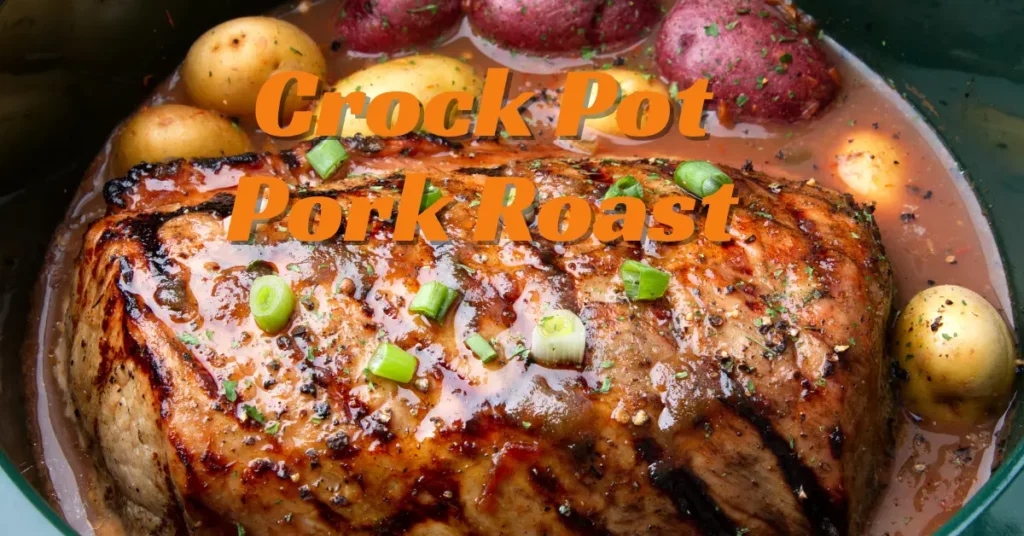This post may contain affiliate links. If you use these links to buy something we may earn a small commission. Thanks.
Cooking a pork roast in a crock pot (slow cooker) is one of the easiest ways to achieve a flavorful, tender, and juicy dish with minimal effort. Whether you’re preparing a weeknight meal or cooking for a special occasion, knowing how long to cook a pork roast properly is key to achieving the best results.
In this guide, we’ll cover everything you need to know, including choosing the right cut, preparation techniques, cooking times, and expert tips to ensure your pork roast turns out perfect every time.
Choosing the Right Pork Roast
Not all pork roasts are created equal, and the cut of meat you choose will impact the cooking time and final texture. Here are the most common cuts used for slow cooking:
1. Pork Shoulder (Boston Butt or Picnic Roast)
- One of the best cuts for slow cooking due to its marbling and fat content.
- Becomes incredibly tender and easy to shred after cooking.
- Ideal for pulled pork, BBQ pork, or hearty roasts.
2. Pork Loin Roast
- A leaner cut compared to pork shoulder.
- Cooks faster and should be monitored to prevent drying out.
- Best for slicing rather than shredding.
3. Pork Butt
- Similar to pork shoulder, with a good balance of fat and meat.
- Great for slow-cooked dishes where a fall-apart texture is desired.
4. Pork Tenderloin
- A very lean cut that cooks much faster than other roasts.
- Not ideal for long slow cooking since it can dry out.
When choosing a pork roast for the crock pot, pork shoulder or pork butt are the best options due to their high fat content, which keeps the meat moist and flavorful.

Preparation Before Cooking
1. Seasoning the Pork
A well-seasoned pork roast makes all the difference. You can use a dry rub, a marinade, or a combination of both. Popular seasoning options include:
- Dry Rub: Salt, black pepper, garlic powder, onion powder, smoked paprika, cumin, and brown sugar.
- Marinade: Soy sauce, apple cider vinegar, Worcestershire sauce, honey, and mustard.
- Herbs and Spices: Thyme, rosemary, oregano, and bay leaves enhance the aroma and flavor.
2. Searing for Extra Flavor
Although optional, searing the pork roast before placing it in the slow cooker adds a rich depth of flavor. Simply heat a pan with oil and sear each side for about 2-3 minutes until browned.
3. Adding Liquid
Slow cookers work best when there’s moisture to keep the meat tender. Some great liquid options include:
- Broth: Chicken, beef, or vegetable broth for a savory base.
- Apple Juice or Cider: Adds a slight sweetness.
- Beer: Gives depth and enhances tenderness.
- BBQ Sauce: Perfect for making pulled pork.
- Water: Works if you prefer a neutral base.
4. Adding Vegetables
If you want a complete one-pot meal, consider adding vegetables like:
- Potatoes
- Carrots
- Onions
- Celery
These veggies will absorb the meat’s flavors and become deliciously tender.
Cooking Time Guidelines
The cooking time depends on the size of the roast and the temperature setting of the crock pot.
| Pork Roast Size | Low Heat (Best for Tenderness) | High Heat (Faster Cooking) |
|---|---|---|
| 2-3 lbs | 6-8 hours | 3-4 hours |
| 3-4 lbs | 8-10 hours | 4-6 hours |
| 5-6 lbs | 10-12 hours | 6-8 hours |
Low vs. High Cooking Setting
- Low heat (190-200°F): Produces the most tender, fall-apart pork, ideal for pulled pork.
- High heat (250-300°F): Works for quicker cooking but may result in slightly less tender meat.
For the best results, cook pork roast on low heat for a longer duration, especially if you’re aiming for that melt-in-your-mouth texture.
How to Tell When It’s Done
Using a meat thermometer is the most accurate way to ensure your pork roast is fully cooked.
Internal Temperature Guide
- 145°F (Medium doneness): Safe to eat but may not be as tender.
- 190-205°F (Best for pulled pork): The meat will shred easily with a fork.
Shredding Test
If the pork falls apart easily when pulled with a fork, it’s ready to be served. If it still feels tough, it likely needs more cooking time.
Resting and Serving the Pork Roast
1. Let It Rest
Before slicing or shredding, let the pork rest for about 10-15 minutes. This helps the juices redistribute, keeping the meat moist.
2. Serving Options
Once cooked, you can serve pork roast in various ways:
- Sliced Pork Roast: Serve with mashed potatoes and gravy.
- Pulled Pork Sandwiches: Toss with BBQ sauce and serve on buns.
- Tacos or Burritos: Use shredded pork as a filling with toppings.
- Pork over Rice or Noodles: A simple and delicious meal idea.
Common Mistakes to Avoid
To get the best results, avoid these common mistakes:
1. Overcooking or Undercooking
- Cooking on high heat for too long can dry out the pork.
- If the meat is tough, it’s likely undercooked and needs more time.
2. Not Using Enough Liquid
Even though pork releases some juices, a small amount of liquid is essential to prevent drying out.
3. Skipping the Searing Step
While optional, searing adds extra depth of flavor and creates a more complex taste.
4. Opening the Lid Too Often
Every time you lift the lid, heat escapes, which can extend the cooking time. Try to resist checking too frequently.
Conclusion
Cooking a pork roast in the crock pot is one of the easiest ways to prepare a flavorful, tender meal with minimal effort. The key is to choose the right cut, season it well, and cook it low and slow for the best results.
If you follow these guidelines, you’ll end up with a perfectly cooked pork roast every time, whether you’re serving it as a classic roast, pulled pork, or something in between.
So grab your slow cooker, pick your favorite seasoning, and enjoy a stress-free, mouthwatering pork roast.
